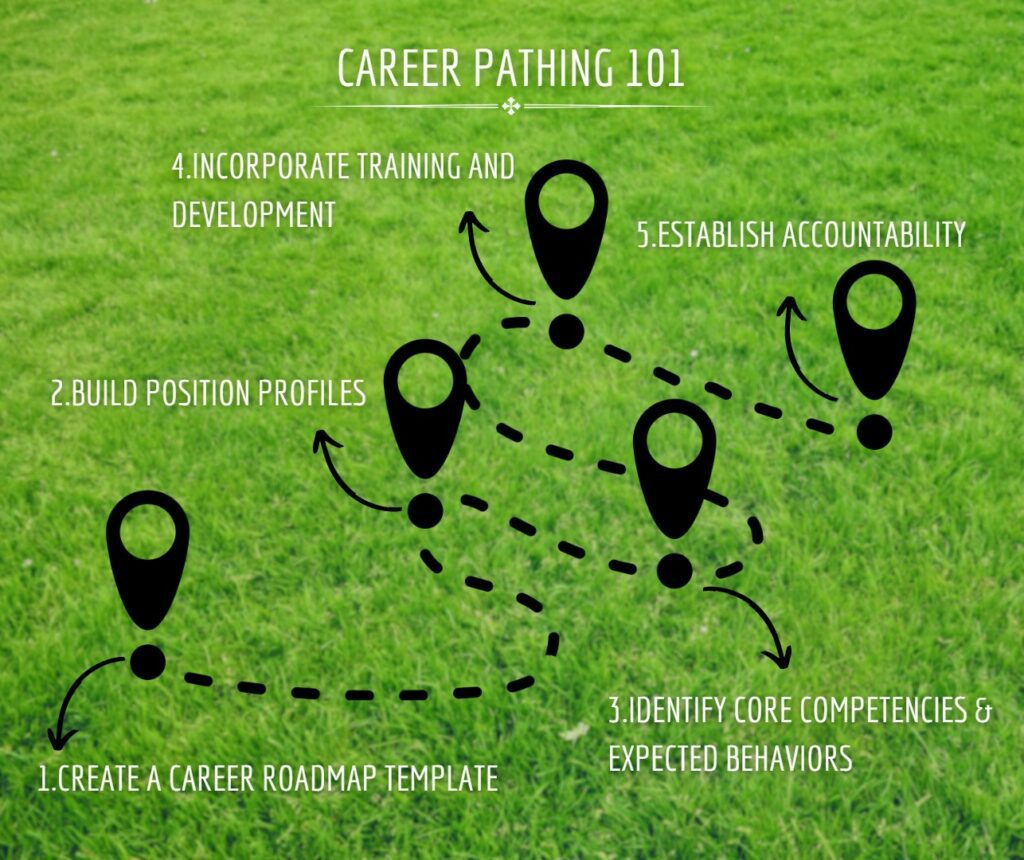A Roadmap to Success: Implementing Career Pathing in Your Organization
Anna Bramlette | 06/01/2023
It’s no secret that the job market is currently very competitive, and as a result, employers must come up with new strategies to attract and retain talented employees. There’s been a lot of research over the past few years on understanding what motivates Millennials and Gen Z workers and how to meet their workplace expectations. Career pathing is a generally new strategy that has proved itself valuable in employee retention.
But what is career pathing?
Simply put, career pathing is the sequence of job positions an individual aims to hold within a company or throughout their entire career. This isn’t just a list of job titles they want to check off—it’s more of a roadmap of short-term and long-term goals to map out their entire career path those positions and reach their ultimate goal. A successful career path is unique to each employee, considering their history, skills, knowledge, and experience.
By presenting employees with a clear plan for career progression, they become more engaged in their roles and the development of their careers. This increases job satisfaction and retention among Millennials. Recent data shows that job satisfaction is at its highest point in 20 years, with 54% of US employees reporting high levels of satisfaction. One consistent contributor to job satisfaction is the potential for future growth. Employees are hungry for career advancement opportunities, as they value career progression more than factors like compensation or organizational stability. This is where career pathing comes into play.
This strategy is valuable to the newer workforce because they are already used to the idea of having their lives mapped out for them. They grew up with the idea of this and expect no different in their professional lives. They’re naturally conditioned to have a clearly defined path forward, and career pathing provides them with that.
Career pathing isn’t just beneficial for employees. Employers can differentiate themselves from competitors by investing in their employees’ career development. It’s also a way for companies to develop the skills they need to achieve future business goals, potentially reducing the need to recruit, hire, and onboard new employees. Plus, by providing a clear path for advancement with predetermined criteria and goals, there are fewer surprises and a happier, more manageable, and easier-to-retain workforce.
Of course, creating a career pathing plan isn’t easy. It takes time and serious thought to develop a logical, attainable path between positions A and B, C, and ultimately position D. Here is a general place to start when designing a career path from scratch:

Step 1: Create a Career Roadmap
This is where you would set expectations for the careers that you would want your employees to hold throughout their working life. For example, you might see that your Administrative Assistant has the potential or desire to become Head of HR someday. That being said, you would need to outline all of the jobs that come between Office Administrator and Head of HR (i.e. HR Generalist, HR Manager, etc.) before anything else during this planning process.
Step 2: Build Position Profiles
In this step, you would need to gather the job description for each position in the road map and place them in a folder. This way, your employees will have clear expectations for what the next position will hold for them.
Step 3: Identify Core Competencies and Expected Behaviors
This is where you need to go into more detail with each job position. Note the required education and experience for each position as well as any prerequisites that your employees would need before entering their new role. Mention any courses that may boost your employees’ chance of getting that promotion quicker! Keep in mind that higher positions require different social responsibilities as well, so make sure you clearly state those as well. For example, if your employee is moving into a management role, that might require them to be less social with their peers and more accountable for their now-subordinates’ behavior and metrics.
Step 4: Incorporate Training and Development
If you have any training courses for these positions, make sure to include them in the road map folders. Whenever your employees are ready for the next step, make sure to share those courses with them. If you don’t have any training programs yet, go ahead and make some or find some online. This is key to getting your employees to the next step!
Step 5: Establish Accountability
Keep checking in on your employees from time to time, making sure they are fully able to achieve their career goals. You might even want to outline a timeframe as a goal for the next step so your team can see where they are going.
Sources: Halilo & Culture Amp
